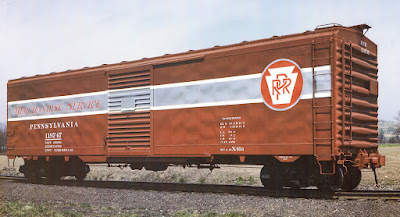 |
| As-built, but upgraded with AB-schedule brakes, ca. 1947-1948 |
The Rock Island received a rather large allocation of 2,500 USRA Specification 1003-B forty-ton, double sheathed box cars. They came from several builders and were assigned to the series 155000-157499. The Rock Island rebuilt two blocks of 400 of these cars in their Armourdale (1936) and Blue Island (1940) shops, creating all-steel cars assigned to the 134000-134799 series. The underframes, ends, and Andrews trucks were retained, although the ends were augmented with small 'blank" sections to increase the height, resulting in a 5/5/blank/5 Murphy configuration (from bottom to top.) New sides from Youngstown Steel and Murphy rectangular panel roofs were applied. They also received Youngstown doors with early Camel Roller Lift fixtures, AB schedule air brakes and power hand brakes. Interestingly, the Rock Island actually continued to operate a greater number of "un-rebuilt" cars than were rebuilt.
Note that the Rock Island also received some secondhand rebuilt CNW USRA box cars, but those are not the subject of this post.
 |
| ca. 1949, courtesy of the late Bill Welch; other info not known by me |
This photo illustrates some of the features, including steel sides of eight, irregularly spaced panels, Youngstown doors, AB brakes (with all three main components on the same side of the center sills,) and Andrews trucks. Note the retention of grab irons instead of ladders. These Rock Island cars had the recessed side sills typical of steel-sided cars rebuilt from wood or composite cars. |
| Ogden, Utah, May 30, 1959, Will Whittaker photo |
In the 1950s, the Rock Island sold cars to the Ft. Dodge, Des Moines and Southern, with very little change in appearance, except the diamond emblem and reporting marks.
Why am I posting about this? Well, over the past several weeks I have been working on one of the Sunshine Models kits for these prototypes. There are a few details that I am opting to change as part of my build. They include:
- add rivets to exposed angle at end of car sides (more on this in subsequent posts; see photo below)
- the kit's doors have later-style Camel Roller Lift fixtures. I am going to replace this detail with an early-style hardware
- Grabs will be created by bending 0.008" wire
- Running boards will be scratchbuilt from strip styrene to achieve a gap between the boards
- I will use a Universal power hand brake and wheel to more closely match the prototype
- Decals to be printed from my own artwork (the Sunshine lettering used a generic sans serif font for the majority of the stenciled data that is a poor match for the Rock Island's lettering)
Progress to this point has involved assembly of the major body parts and little else. I can report one issue that I encountered: the rectangular-shaped underside of the kit's resin roof casting was too long to easily fit into the car body. Instead of what would have been a fairly tedious process of removing resin material from the underside of the roof casting, I put the resin roof casting aside to use on a project where it fits into a car body and instead used a far more easily modified styrene part. The photos below illustrate the removal of material to facilitate a good fit, showing both modified and unmodified IMWX/Red Caboose parts. More details to follow in subsequent posts...
 |
| The visible "end" of the side that is nested in the angle formed by the side and end had rivets on the prototype. These will be simulated with decal rivets on the model. Also, note the "blank" end panel added to the rebuilds, as noted in the text above |

















































